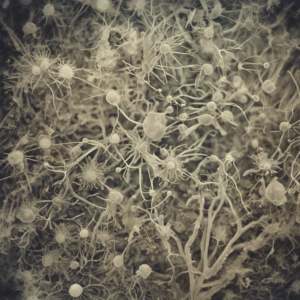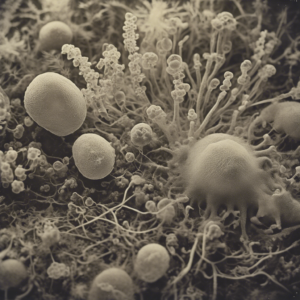Advanced Microbial Biotechnologies for the Remediation of Polluted Aquatic Ecosystems: A Case Study of River and Lake Restoration
 The health of aquatic ecosystems is a critical component of global biodiversity, human well-being, and the sustainability of natural resources. However, freshwater bodies such as lakes and rivers are increasingly compromised by anthropogenic activities, resulting in a range of ecological disturbances. Among these, nutrient overloading, organic matter deposition, heavy metal contamination, and pathogen introduction are particularly concerning. These issues contribute to the degradation of water quality, leading to phenomena such as eutrophication, loss of aquatic biodiversity, and threats to public health due to the contamination of drinking water sources.
The health of aquatic ecosystems is a critical component of global biodiversity, human well-being, and the sustainability of natural resources. However, freshwater bodies such as lakes and rivers are increasingly compromised by anthropogenic activities, resulting in a range of ecological disturbances. Among these, nutrient overloading, organic matter deposition, heavy metal contamination, and pathogen introduction are particularly concerning. These issues contribute to the degradation of water quality, leading to phenomena such as eutrophication, loss of aquatic biodiversity, and threats to public health due to the contamination of drinking water sources.
Conventional remediation techniques—ranging from physical extraction of pollutants to chemical treatments and mechanical aeration—have been employed to address these challenges. However, these methods are often limited by high costs, potential for secondary pollution, and short-term efficacy. In contrast, bioremediation, which employs living organisms to degrade, transform, or detoxify contaminants, offers a sustainable and ecologically sound alternative.
Microbebio has developed proprietary microbial formulations tailored for the bioremediation of polluted aquatic ecosystems. These formulations leverage the metabolic capabilities of specific microbial consortia to restore the ecological balance of lakes and rivers. This paper provides a detailed examination of the scientific principles underlying the efficacy of Microbebio’s microbial technologies and their potential impact on the remediation of freshwater ecosystems.
Microbial Mechanisms in Bioremediation
Microorganisms—particularly bacteria, fungi, and algae—are central to biogeochemical cycles in aquatic environments. Their roles include the decomposition of organic matter, nitrogen fixation, phosphorus solubilization, and the degradation of various pollutants. Microbebio’s proprietary formulations are engineered to optimize these natural processes in contaminated water bodies. The formulations consist of a consortium of bacteria, fungi, and algae selected based on their metabolic potential, resilience to environmental stressors, and synergistic interactions.
Bacterial Consortia
Bacteria are pivotal in the bioremediation process due to their ability to degrade a wide array of organic and inorganic pollutants. Microbebio’s formulations incorporate bacterial strains with specific metabolic capabilities for degrading hydrocarbons, pesticides, heavy metals, and other toxic substances frequently found in polluted aquatic environments. For example, strains of *Pseudomonas* and *Bacillus* are noted for their hydrocarbon degradation abilities, while *Desulfovibrio* species excel in sulfate reduction and acid mine drainage remediation.
Bacterial degradation of pollutants occurs via various metabolic pathways, including aerobic and anaerobic respiration, fermentation, and co-metabolism. Under aerobic conditions, bacteria utilize oxygen as a terminal electron acceptor, breaking down organic pollutants into carbon dioxide, water, and biomass. In anoxic environments, bacteria employ alternative electron acceptors such as nitrate, sulfate, or metals, enabling them to degrade pollutants in oxygen-depleted zones, which are commonly encountered in polluted lakes and rivers.
Fungal Components
Fungi contribute to bioremediation by degrading complex organic compounds, such as lignin and cellulose, which are resistant to bacterial degradation. Microbebio’s formulations include white-rot fungi such as *Phanerochaete chrysosporium*, which is renowned for its ligninolytic enzymes capable of breaking down a wide range of pollutants, including synthetic dyes, polycyclic aromatic hydrocarbons (PAHs), and certain pesticides. These fungi secrete extracellular enzymes—such as laccases, peroxidases, and cellulases—which initiate the degradation of large, complex molecules into smaller, more bioavailable forms.
Fungi also play a significant role in heavy metal remediation through biosorption, whereby fungal biomass binds and concentrates heavy metals from the surrounding water. The combination of bacterial and fungal components in Microbebio’s formulations ensures a comprehensive approach to pollutant degradation, addressing both easily degradable substances and more recalcitrant contaminants.
 Algal Contributions
Algal Contributions
Algae, particularly microalgae, are included in Microbebio’s formulations to enhance the removal of excess nutrients, such as nitrogen and phosphorus, from polluted water bodies. These nutrients, often introduced through agricultural runoff and wastewater, can lead to eutrophication, characterized by algal blooms, hypoxia, and the subsequent decline of aquatic fauna. Microalgae assimilate these nutrients into their biomass, thereby reducing their concentration in the water.
Furthermore, certain microalgae contribute to the degradation of organic pollutants by producing extracellular enzymes and fostering the growth of pollutant-degrading bacteria in their proximity. Algae also play a vital role in oxygen production through photosynthesis, which can alleviate hypoxic conditions in polluted waters.
Operational Mechanisms in Aquatic Ecosystem Restoration
The success of Microbebio’s microbial formulations in the remediation of lakes and rivers is attributable to several interrelated mechanisms, including pollutant degradation, nutrient cycling, bioaugmentation, and overall ecological restoration.
Pollutant Degradation
The primary mechanism by which Microbebio’s microbial formulations restore water quality is through the degradation of pollutants. The microbial consortia target specific pollutants, leveraging their metabolic pathways to break down these substances into less harmful compounds. Hydrocarbons, for example, are oxidized by bacteria through a series of redox reactions, resulting in their conversion to carbon dioxide and water. Similarly, organic pollutants, such as pesticides and dyes, are metabolized by bacterial and fungal enzymes into less toxic intermediates or are fully mineralized.
For heavy metals, which cannot be degraded, microbial processes such as biosorption, bioaccumulation, and biotransformation are employed. Bacteria and fungi can sequester heavy metals by binding them to their cell walls or by transforming them into less toxic forms, thereby reducing their bioavailability and toxicity in the aquatic environment.
Nutrient Cycling and Eutrophication Control
Eutrophication is a critical challenge in polluted water bodies, leading to harmful algal blooms, oxygen depletion, and the subsequent collapse of aquatic ecosystems. Microbebio’s formulations include microbial species that enhance nutrient cycling, particularly the cycling of nitrogen and phosphorus. These microbes convert excess nutrients into biomass or, in the case of nitrogen, into gaseous forms through processes such as denitrification, thereby reducing the nutrient load and preventing eutrophication.
The inclusion of microalgae in the formulations further supports nutrient removal and contributes to the oxygenation of the water via photosynthesis. This dual approach not only mitigates eutrophication but also restores the oxygen balance, supporting the recovery of aquatic life.
Bioaugmentation
Bioaugmentation—the introduction of selected microorganisms to accelerate the degradation of contaminants—is a fundamental aspect of Microbebio’s bioremediation strategy. The proprietary formulations are designed to enhance the natural microbial communities within the water, providing them with additional metabolic capacities to more efficiently degrade pollutants. By introducing microbes specifically adapted to the prevailing contaminants, Microbebio’s formulations achieve rapid and effective bioremediation.
The success of bioaugmentation depends on the ability of the introduced microbes to survive, proliferate, and remain metabolically active within the aquatic environment. Microbebio’s formulations include robust microbial strains capable of withstanding environmental stressors such as fluctuations in temperature, pH, and salinity, ensuring their effectiveness across diverse aquatic ecosystems.
Ecological Restoration
Beyond pollutant degradation and nutrient reduction, Microbebio’s microbial formulations contribute to the broader ecological restoration of polluted water bodies. By breaking down contaminants and lowering nutrient concentrations, these microbes help restore the natural balance of the ecosystem, facilitating the recovery of native aquatic species. This restoration of biodiversity is essential for the long-term health and resilience of lakes and rivers.
Moreover, microbial activity in lake and river sediments plays a critical role in sediment bioremediation. Pollutants often accumulate in sediments, posing long-term environmental risks. Microbebio’s formulations include microbes capable of degrading contaminants in both the water column and sediments, ensuring a comprehensive cleanup of the entire aquatic ecosystem.
Case Studies in Bioremediation
Field applications of Microbebio’s microbial formulations have demonstrated their efficacy in various polluted water bodies worldwide. These case studies underscore the adaptability and effectiveness of these formulations in addressing diverse pollution challenges.
 Lake Remediation in Southeast Asia
Lake Remediation in Southeast Asia
A large lake in Southeast Asia, suffering from severe eutrophication and contamination from industrial effluents—including heavy metals and organic pollutants—was selected for bioremediation. The local government sought a sustainable solution that would not only restore water quality but also rehabilitate the lake’s ecological health. Microbebio’s proprietary microbial formulations were applied over several months.
The results were significant: nutrient concentrations in the water were reduced by over 60%, leading to a substantial decrease in algal blooms. Concurrently, microbial activity has led to the degradation of industrial pollutants, reducing their concentrations to levels that are compliant with environmental standards. The oxygen levels in the lake improved, supporting the recovery of aquatic life, including fish and aquatic plants. The lake, once considered a “dead zone,” was revitalized into a functional and thriving ecosystem.
River Restoration in North America
A river in North America, heavily impacted by agricultural runoff containing pesticides, fertilizers, and organic waste, was targeted for remediation using Microbebio’s microbial formulations. The river had experienced frequent fish kills, reduced biodiversity, and poor water quality due to high pollutant loads and hypoxia.
Following the application of Microbebio’s formulations, the river saw rapid improvements in water quality. Pesticide concentrations were reduced by over 70%, and nutrient levels dropped significantly, curtailing further eutrophication. Increased oxygen levels supported the return of fish and other aquatic species. The microbial consortia continued to function effectively, providing ongoing remediation and contributing to the long-term recovery of the river ecosystem.
Sediment Remediation in a European Lake
In Europe, a lake with a history of pollution had accumulated a substantial layer of contaminated sediments, posing a significant ecological threat. Microbebio’s formulations were introduced to the sediments to accelerate the degradation of organic pollutants and reduce the bioavailability of heavy metals.
